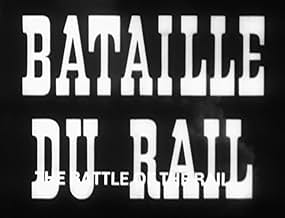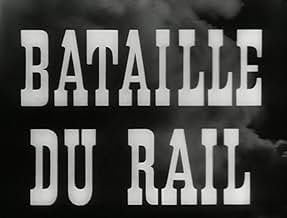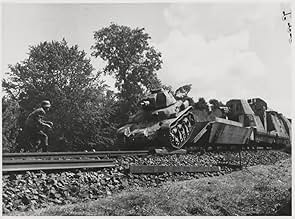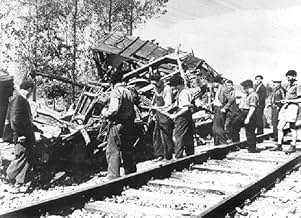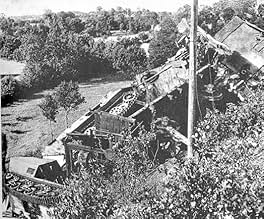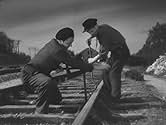IMDb-BEWERTUNG
7,0/10
1404
IHRE BEWERTUNG
Dieser Film ist eine Geschichte über die französischen Eisenbahnarbeiter, die während der deutschen Besatzung im Zweiten Weltkrieg Teil des organisierten Widerstands waren.Dieser Film ist eine Geschichte über die französischen Eisenbahnarbeiter, die während der deutschen Besatzung im Zweiten Weltkrieg Teil des organisierten Widerstands waren.Dieser Film ist eine Geschichte über die französischen Eisenbahnarbeiter, die während der deutschen Besatzung im Zweiten Weltkrieg Teil des organisierten Widerstands waren.
- Regie
- Drehbuch
- Hauptbesetzung
- Auszeichnungen
- 3 Gewinne & 1 Nominierung insgesamt
Marcel Barnault
- Cheminot
- (as Barnault)
Jean Clarieux
- Lampin
- (as Clarieux)
Jean Daurand
- Cheminot
- (as Daurand)
Lucien Desagneaux
- Athos
- (as Desagneaux)
François Joux
- Cheminot
- (as Joux)
Pierre Latour
- Cheminot
- (as Latour)
Robert Le Ray
- Chef de gare
- (as Leray)
Pierre Lozach
- Cheminot
- (as Lozach)
Pierre Mindaist
- Cheminot
- (as Mindaist)
Léon Pauléon
- Chef de gare St-André
- (as Pauleon)
Fernand Rauzéna
- Cheminot
- (as Rauzena)
Michel Salina
- Allemand
- (as Salina)
Charles Boyer
- Narrator
- (Synchronisation)
- (Nicht genannt)
Empfohlene Bewertungen
René Clément directed this exceptional film which captures an important but often ignored part of the Allied war effort in WWII. It chronicles the efforts by the French railway workers to hinder the German war machine. What makes the film work wonderfully is the non-professional actors--like the Neo-realist actors in post-war Italian films (such as by DeSica and Rossellini). This gives the movie a great sense of realism--almost like a documentary that was somehow filmed as events really took place--though it was made just after the war.
The film begins sometime after the German occupation began--it's never exactly certain. During this time, random acts of sabotage occur but they are mostly annoying and are seemingly unorganized. However, partway through the film, the Resistance receives word that the Normandy invasion has occurred. Suddenly, the full extent of the French Resistance is obvious, as the entire effort to use the rails to reinforce the German army are frustrated in many, many ways--ranging from sabotaging the tracks and equipment to even attacks on the trains themselves by partisans.
"La Bataille du Rail" ("The Battle of the Rails") works very well--mostly because in addition to the non-actors working in the film, the director and writers (one of which was the director himself) used a lot of tense little vignettes in the film to draw in the viewer. Perhaps some today might find it all a bit boring (after all, they are more interested, perhaps, in seeing the newest Brandon Frazier film), but as a history teacher, I think it's a must-see! Wonderful.
By the way, you can't blame the film makers for this, but the print I saw was pretty shabby. It had a lot of scratches and the white captions were poor--blending into the scenes at times and also, occasionally, mistranslated or using jargon that is too technical (full of railroad terms and jargon). I would LOVE to see this film restored and re-captioned!
The film begins sometime after the German occupation began--it's never exactly certain. During this time, random acts of sabotage occur but they are mostly annoying and are seemingly unorganized. However, partway through the film, the Resistance receives word that the Normandy invasion has occurred. Suddenly, the full extent of the French Resistance is obvious, as the entire effort to use the rails to reinforce the German army are frustrated in many, many ways--ranging from sabotaging the tracks and equipment to even attacks on the trains themselves by partisans.
"La Bataille du Rail" ("The Battle of the Rails") works very well--mostly because in addition to the non-actors working in the film, the director and writers (one of which was the director himself) used a lot of tense little vignettes in the film to draw in the viewer. Perhaps some today might find it all a bit boring (after all, they are more interested, perhaps, in seeing the newest Brandon Frazier film), but as a history teacher, I think it's a must-see! Wonderful.
By the way, you can't blame the film makers for this, but the print I saw was pretty shabby. It had a lot of scratches and the white captions were poor--blending into the scenes at times and also, occasionally, mistranslated or using jargon that is too technical (full of railroad terms and jargon). I would LOVE to see this film restored and re-captioned!
This movie is not great. It's good, and it's only ok if you've already seen The Train 1964. This 1946 movie is artistic, stark, neo realist, blah blah, like many post war European made movies from the era. But it lacks character study and has only tactical measures and rebelliousness against not-so-evil Nazis as the reason for being, unlike The Train.
Army of Shadows 1969 is another example of a refined, not-so-purist remake of previous movies. It was just done better and had a longer lasting impact, like The Train.
But telling fans of La Bataille Du Rail that it's overrated just gets a lot of dislikes. Examine both movies yourself, but make sure you watch the 1946 movie FIRST so you won't be disappointed.
Army of Shadows 1969 is another example of a refined, not-so-purist remake of previous movies. It was just done better and had a longer lasting impact, like The Train.
But telling fans of La Bataille Du Rail that it's overrated just gets a lot of dislikes. Examine both movies yourself, but make sure you watch the 1946 movie FIRST so you won't be disappointed.
I usually stop watching films when I discover that it has subtitles but I'm glad that I didn't with this one. Stopping German supplies and reinforcements reaching Normandy contributed greatly to the advancement of the Allies, many trains, and rail tracks, were destroyed by the RAF in the run up to the invasion but the events in this film also helped greatly.
After the war the French were very keen to show that they didn't just capitulate ASAP but had an active resistance movement but in the many WWII history books I've read their overall contribution to the victory In Europe is considered to be minimal.
Regardless of that this film is very well worth watching.
After the war the French were very keen to show that they didn't just capitulate ASAP but had an active resistance movement but in the many WWII history books I've read their overall contribution to the victory In Europe is considered to be minimal.
Regardless of that this film is very well worth watching.
A hidden gem l just discovered !! Tells it like it was !! Dirty , hard , people died . Very good de-railment scene towards the end !! A real derailment excellently shot !
Based on real life events that occurred between the Normandy Landings and the liberation, La Bataille du Rail was commissioned by the Associations of the Resistance soon after the end of the Second World War. That a war film would be put into production so soon after the end of the war and that it would prove so successful with a public that lived through it suggests a desire to show the extent of the resistance's achievements and the pride of the French.
However, Clément carefully avoids making the film too didactic or sentimental. We can see how the ruthlessness of the occupying forces in rooting out the saboteurs and their anti-Semitism is not overplayed as their portrayal seems appropriate to a modern audience not directly scarred by the events shown. Another way in which he achieves this is through the way the camera stays relatively detached from the action, showing the events almost like a documentary rather than forcing us to identify with any of the characters. It has been said that the cast was made up of unprofessional actors and in some cases real railwaymen. This adds to the realism and creates an effect where no one film star stands out as an obvious "hero", enforcing a message of "ordinary men doing what they had to".
However, Clément carefully avoids making the film too didactic or sentimental. We can see how the ruthlessness of the occupying forces in rooting out the saboteurs and their anti-Semitism is not overplayed as their portrayal seems appropriate to a modern audience not directly scarred by the events shown. Another way in which he achieves this is through the way the camera stays relatively detached from the action, showing the events almost like a documentary rather than forcing us to identify with any of the characters. It has been said that the cast was made up of unprofessional actors and in some cases real railwaymen. This adds to the realism and creates an effect where no one film star stands out as an obvious "hero", enforcing a message of "ordinary men doing what they had to".
Wusstest du schon
- WissenswertesIn part financed by what had been the Resistance as a way of showing international audiences what the French population had been facing under Nazi oppression. The Resistance was also keen to let the world know that they had been actively involved in disrupting the German war machine in France as the international perception at the time was that the French had capitulated and collaborated a little too easily with their Nazi captors.
- PatzerRailway worker tapping Morse code just repeats letter "V" most of the time with only a few exceptions.
- Crazy Credits(in cast) et Les cheminots de France
- VerbindungenFeatured in Cannes... les 400 coups (1997)
Top-Auswahl
Melde dich zum Bewerten an und greife auf die Watchlist für personalisierte Empfehlungen zu.
- How long is The Battle of the Rails?Powered by Alexa
Details
- Erscheinungsdatum
- Herkunftsland
- Offizielle Standorte
- Sprachen
- Auch bekannt als
- Die Schienenschlacht
- Drehorte
- Gare SNCF, Saint-Brieuc, Côtes-d'Armor, Frankreich(first scenes, train station)
- Produktionsfirmen
- Weitere beteiligte Unternehmen bei IMDbPro anzeigen
- Laufzeit1 Stunde 25 Minuten
- Farbe
- Sound-Mix
- Seitenverhältnis
- 1.37 : 1
Zu dieser Seite beitragen
Bearbeitung vorschlagen oder fehlenden Inhalt hinzufügen

